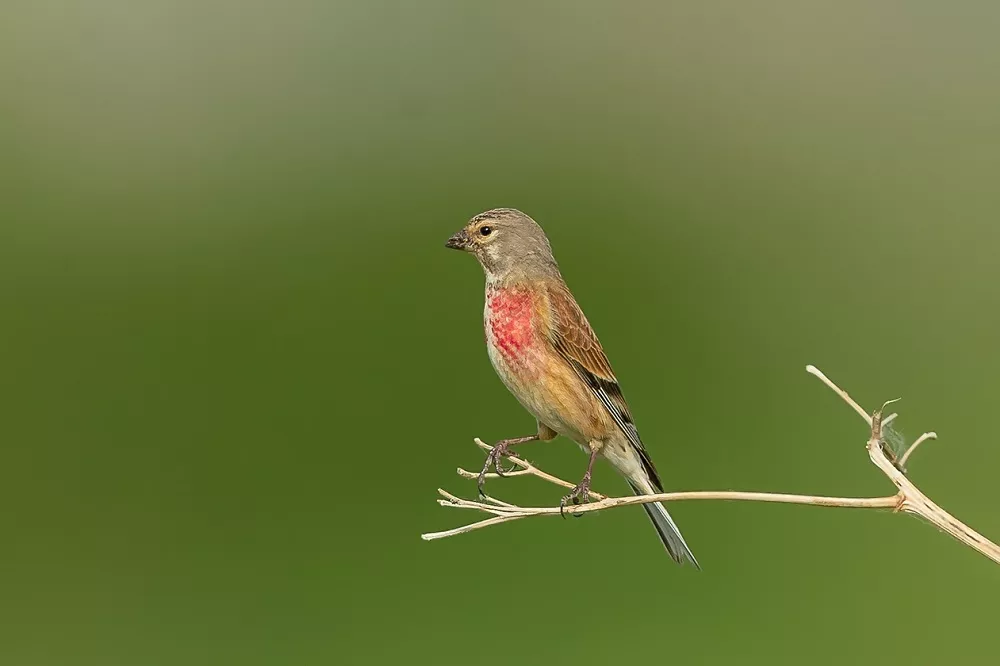The Common Linnet (Linaria cannabina) is a charming passerine bird known for its distinctive appearance and melodious song. Found across various regions of Europe, Asia, and North Africa, this adaptable species has successfully established itself in diverse habitats. In this article, we delve into the habitat preferences of the Common Linnet, shedding light on where it resides and thrives in its natural environment.
Habitats
Common linnets are adaptable birds that can thrive in various habitats. They prefer open areas with low vegetation, such as heaths, moors, grasslands, and farmlands. They also inhabit coastal dunes, sand dunes, and scrubby areas near the coast.
During the breeding season, common linnets require dense shrubs and bushes for nesting and hiding from predators. They also need food sources, such as seeds, insects, and berries. In the winter, they are more likely to inhabit agricultural fields and grasslands where they can find abundant food.
Distribution
Common linnets have a vast distribution range that spans across Europe, northern Africa, and western Asia. They breed in northern and central Europe, including the British Isles, Scandinavia, Germany, France, Spain, and Italy. Their breeding range extends eastwards up to western Russia and Kazakhstan.
In North Africa, common linnets breed in Morocco, Algeria, Tunisia, and Egypt. In western Asia, they breed in Turkey, the Caucasus region, and Iran. During the winter, common linnets migrate southwards to the Mediterranean region, the Middle East, and North Africa.
Across its range, this species shows some variation in habitat preference, but it is generally considered an open landscape bird.
Open Habitats and Farmlands
The Common Linnet is most commonly found in open habitats and semi-open areas, favoring a range of environments that provide a mix of suitable resources for feeding and nesting. These include grasslands, heathlands, moorlands, meadows, and agricultural fields such as farmlands and cultivated areas.
Grassy Areas and Fields
Within its preferred open habitats, the Common Linnet shows a particular affinity for grassy areas and fields. It frequents grasslands with patches of low vegetation, where it can forage for seeds and insects. These areas may include meadows, pastures, and abandoned farmlands, providing the bird with ample food resources.
Farmlands and Cultivated Areas
The Common Linnet has successfully adapted to human-altered landscapes and often utilizes agricultural fields and cultivated areas. It is frequently encountered in fields of cereal crops, such as wheat, oats, barley, and rye, where it can find an abundant supply of seeds, especially during the breeding season. The availability of diverse seed sources in these areas makes them attractive for foraging and nesting.
Woodlands and Forest Edges
Although the Common Linnet is primarily associated with open habitats, it can also be observed in woodlands and forest edges. It tends to favor areas where trees and shrubs meet open spaces, allowing the bird to access both sheltered nesting sites and nearby foraging grounds. Woodlands with a mix of coniferous and deciduous trees, as well as hedgerows and scrubland, offer suitable habitats for the species.
Coastal Areas
In some regions, particularly along coastal areas, the Common Linnet can be found in dunes, coastal grasslands, and salt marshes. These habitats provide a diverse array of plant species, including sea buckthorn, which offers an important food source for the bird. Coastal environments also provide nesting sites and refuge during migration.
Migration Patterns
Common linnets are migratory birds that exhibit partial migration. This means that some populations migrate to warmer regions during the winter while others remain in their breeding grounds all year round. The extent of migration depends on the availability of food and weather conditions.
In general, northern populations of common linnets migrate southwards to avoid harsh winters. They start their migration in September and return to their breeding grounds in March or April. Southern populations are more sedentary, although some birds may move to lower altitudes during the winter.
During migration, common linnets form flocks that can range from a few individuals to several hundred birds. They fly in a V-shaped formation to reduce wind resistance and conserve energy. They also use landmarks, celestial cues, and magnetic fields to navigate.
Conservation Status
Common linnets are widespread and abundant birds with a stable population trend. The International Union for Conservation of Nature (IUCN) has assessed them as a species of least concern. However, they face threats from habitat loss, pesticides, and hunting.
Farmland intensification and urbanization have reduced the availability of suitable habitats for common linnets. Pesticides used in agriculture can affect their food sources and cause direct mortality. Hunting, particularly in southern Europe and North Africa, can also impact their populations.
Conclusion:
The Common Linnet is an adaptable and widely distributed species, occupying a range of habitats across Europe, Asia, and North Africa. It thrives in open landscapes, including grasslands, meadows, agricultural fields, and woodland edges. Its ability to exploit human-altered environments, such as farmlands, highlights its resilience and flexibility. Understanding the habitat preferences of the Common Linnet is crucial for conservation efforts, as it aids in the preservation of suitable habitats and the diverse ecosystems the species relies upon for its survival and continued presence in the natural world.
Related topics:


 Facebook
Facebook  Instagram
Instagram  Youtube
Youtube 